
All images © by Roberto Piperno, owner of the domain. Write to romapip@quipo.it.
Notes:
Page revised in March 2021.

All images © by Roberto Piperno, owner of the domain. Write to romapip@quipo.it.
Notes:
Page revised in March 2021.
 - Castelrosso (Kastelorizo)
- Castelrosso (Kastelorizo)You may wish to see an introductory page first.
On the second of July one thousand seven hundred and thirty nine
I embarked at Alexandria, on board a Scotch vessel bound to Tunis, Algiers, and some other places on the coast of Africa, freighted with Moors on their return from Mecca; I was to be landed at
Canea in Candia, if the wind would permit. On the eighth we saw
that part of the coast of Caramania, which by the antients was called
Pamphylia, and were almost opposite to Satalia, the antient
Attalia. (..) In the evening we came up with the island called Castello Rosso. (..) It may be that island which Strabo says, had a road for ships; (..) it is high and rocky,
and about two miles in length.
Richard Pococke - A Description of the East and Some Other Countries - 1745
Castelrosso is a very small island located 72 miles to the east of Rhodes and only two miles off the Turkish coast. In ancient times it was called Megisti (Greatest) with reference to a group of islets next to it.

View of the bay and of the town
There is a town and castle on the
highest part of it, and the south side of this island seemed to be covered
with vineyards; there is a secure harbour to the north, and they told
me that it was not above half a mile from the continent. Pococke
We proceeded along
a high rugged shore; and after several barren islands, the ship anchored off the harbour and town of Kastelorizo,
on the eastern side of a large rocky island
of that name. The harbour, though small, is snug; merchant ships of any
size can moor within a hundred yards
of the houses; and on the opposite side
they may even lie so close to the shore
as that it may be reached by means of a
plank. (..) Pilots may generally be met with here, for vessels bound
to any part of this coast, or to Syria
and even to Egypt; for Alexandria is
supplied, in a great measure, with fuel
from the woody mountains of Karamania, there is a constant intercourse between that place and this little port.
Francis Beaufort, Captain of HMS Frederikssteen, a frigate of 32 guns: Karamania; or a brief description of the South Coast of Asia Minor, and of the Remains of Antiquity collected during a survey of that coast, under the orders of the Lords Commissioners of the Admiralty, in the years 1811 & 1812 - Published in 1817
Its current name derives from the castle built by the Knights of St. John who
occupied the island in 1306 as a useful base prior to landing on Rhodes. The only valuable resource of the island was its well repaired bay.
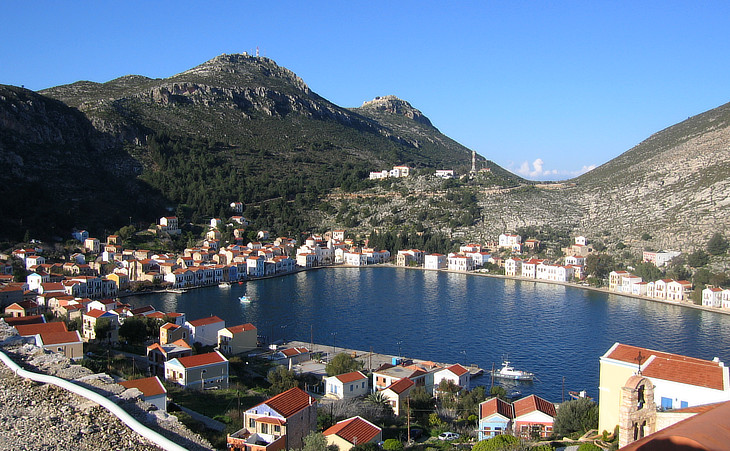
Another view of the bay with the mountain where another fortress stood (it is still a military zone)
Two old castles command the town, the harbour, and the outer anchorage; but in a former War they were taken by the Russians, and almost destroyed. From the uppermost, which stands on a picturesque cliff, the muzzles of a few small cannon still project; but the Turks, to conceal its weakness, allow no stranger to enter. On the summit of the island, which is about eight hundred feet above the level of the sea, there is another small ruined fortress, which from its situation must have been impregnable. Beaufort
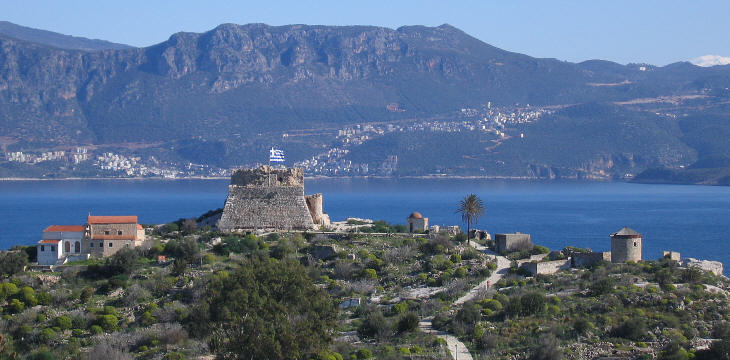
View of the fortress and of the Asian coast with the town of Kas (Antiphellos) (see the island from that town)
Kastelorizo forms the west side of a
gulf which is crowded with small islands
and rocks; and which communicates
with two capacious harbours, Sevedo
and Vathy (today's Kas). (..)
(..) The town is principally inhabited by
Greeks, but under the government of a
Turkish Agha, who is dependant on
the Bey of Rhodes. Beaufort
Yesterday we went to the island of Kastelorizo, to
lay in stores and to refit ourselves with supplies; the
distance may be five or six miles from the shore. (..) We were told that there were five
Turks only in the town, the whole population being
Greek.
Charles Fellows - An account of discoveries in Lycia - 1841
Since 1945 the island belongs to Greece and is the easternmost point of the country; due to tense relations between Greece and Turkey a large part of it is under military control. Hopefully since the 1990s the two countries are on a "building trust" path: the Greek sentinels who from the old castle are in charge of checking with binoculars the enemy's move, spend their day fiddling with cellular phones.
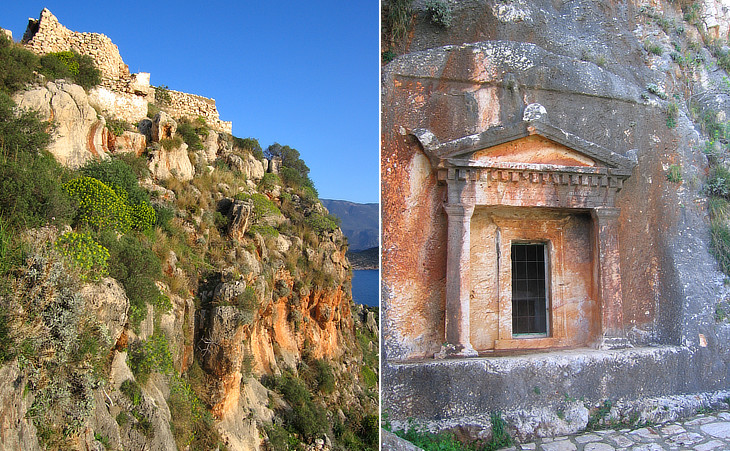
(left) The red rocks under the fortress; (right) Lycian tomb
In this island an
ochry drip, exuding from between the
strata gives a reddish tinge to the cliffs. From this circumstance it probably acquired the Italian name of Castelrosso
and it is not impossible that the present
name, Kastelorizo, which has no signification in modern Greek, or Turkish
may be derived from thence. Beaufort
The island of Kastelorizo, which was the ancient
Megiste, is perfectly barren of natural supplies. (..) We
ascended the heights above the town, to seek the ruins
of the city of the early inhabitants: some
fine Cyclopean walls scattered about the top point out
the site, but no further remains are to be traced. Fellows
Castelrosso in Italian means red castle and it is generally thought that the name is a reference to its red rocks; in some old maps however it was called
Castel d'Orizzo or Castel Ruggio which some believe to be a reference to Grand Master Juan Fernando Heredia (1377-1396) who strengthened the castle. It is not to be confused with the Venetian fortress of Castelrosso di Negroponte.
Ancient Megisti was part of Lycia, a region of today's Turkey known for its rock cut tombs, one of which is located on the cliff below the castle; similar tombs can be seen also at Antiphellos.
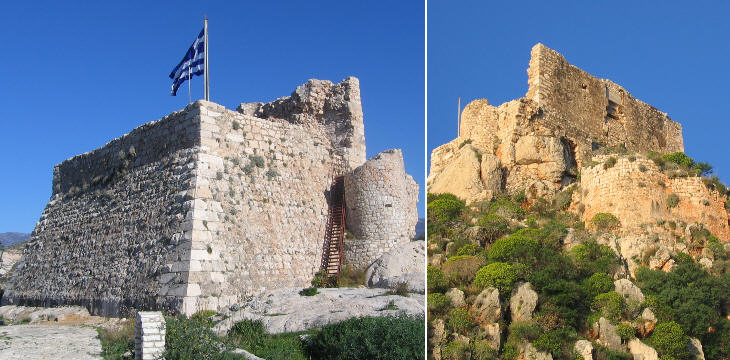
Southern (left) and northern (right) sides of the remaining tower
Vertot says, that the knights of Rhodes
kept possession of this island till the year
1440: and these castles and fortifications, which appear to have the character of the European architecture of the middle ages, may have been their work. Beaufort
The Grand Masters of Rhodes considered Castelrosso as an exile location and they sent there the knights who breached the rules of the Order. In 1440 the island was raided by the Mameluke Sultan of Egypt and the castle was greatly damaged; the Ottomans briefly seized the island in 1479; in 1522, during the war which led to the capitulation of Rhodes, they occupied it on a permanent basis.
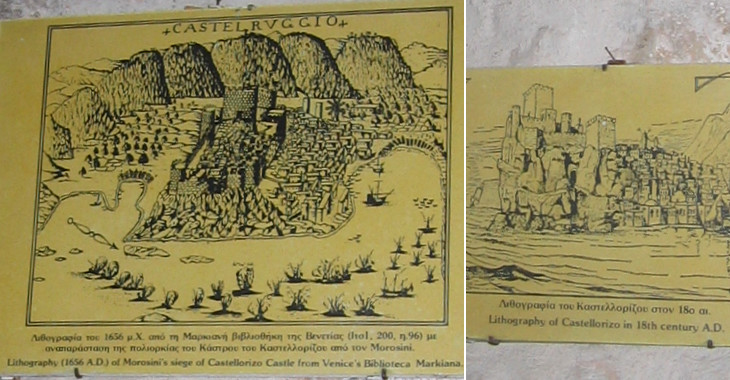
Local small museum: (left) the Venetian siege of Castelrosso in 1656; (right) 18th century view of the town
In 1570 the Ottomans landed on Cyprus (at the time a Venetian possession); they easily conquered Nicosia
and Kyrenia. The Venetian navy moved out of Crete in order to bring supplies to Famagusta, the main town of Cyprus which the Ottomans had not yet managed to conquer. The Venetians occupied Castelrosso and used it as an advanced base for their navy until the fall of Famagusta in 1571.
The Venetians led by Francesco Morosini raided the island again in 1656 and dismantled the castle: the raid was carried out to create a diversion during the Siege of Candia.
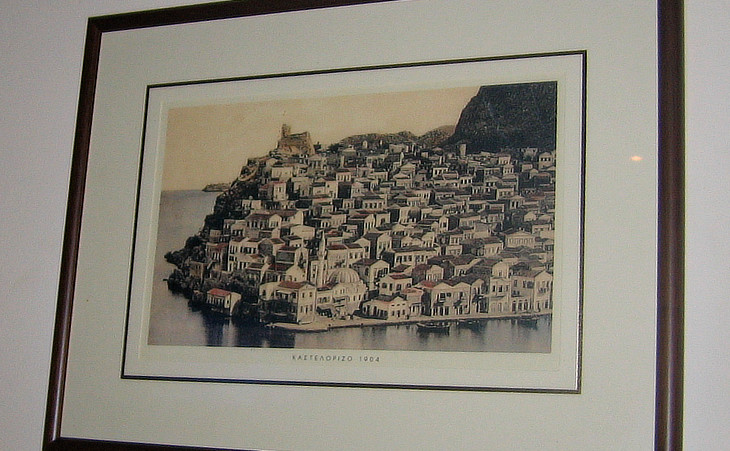
Local small museum: 1904 view of the town
The
town - for it really deserves the name - consists probably of six or eight hundred houses, all built upon one
model, being formed like cubes, with two or three open
square windows in the front of each, and a door at the
back. These are built up the side of a steep rock, and,
viewed together, are more singular-looking than picturesque. An old castle of the middle ages crowns the
rock, and gives a character to the city. (..) A number of small vessels filled the harbour;
boats were building, houses rising rapidly, and the whole
population seemed active and enterprising: it is quite
delightful to see such an intelligent-looking assemblage
of people, both male and female, in this busy scene. (..) This is a metropolis of trade for the whole of the
south-western coast: all provisions, and even coins and
treasures of every kind discovered by the peasants, find
a ready market here. I have obtained several coins,
just brought from the valley of the Xanthus, and also
saw some singular gems. Fellows
In the XIXth century Castelrosso knew a period of great prosperity as an intermediate call on the route between the Aegean Sea and the Near East. Apart from a small Ottoman garrison, the governor and a few civil servants, the inhabitants were all Greek.
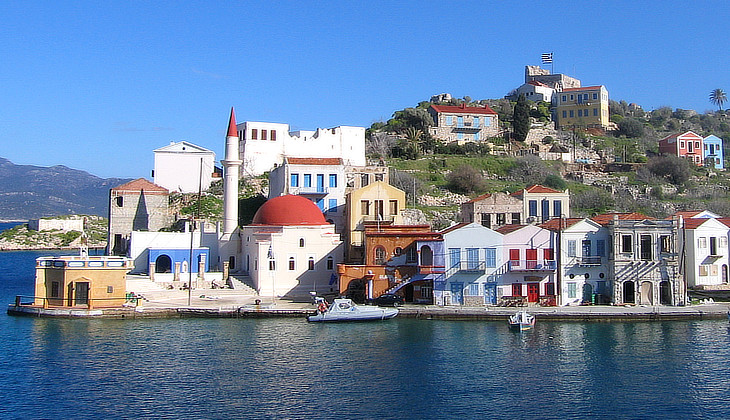
The town today
On landing in this island, the effect was that of
visiting a new country: hundreds of Greeks were
crowding about the little quay and coffee-houses; wine
was being retailed from the cask in the dirty narrow
streets; scarcely a dog was to be seen, and pigs supplied their place. Fellows
In 1912, during the
Italo-Turkish War, there was a rebellion against the Ottoman rule: this started a long period of trouble which worsened during WWI when Castelrosso was occupied by French troops and the Ottomans shelled it from the mainland. Eventually the island was assigned to Italy and included in the Dodecanese possession; its good days however were gone forever. A survey made by Italian authorities found that half of the houses were abandoned: in addition the bay was too small for modern ships and maritime routes no longer followed the coast.
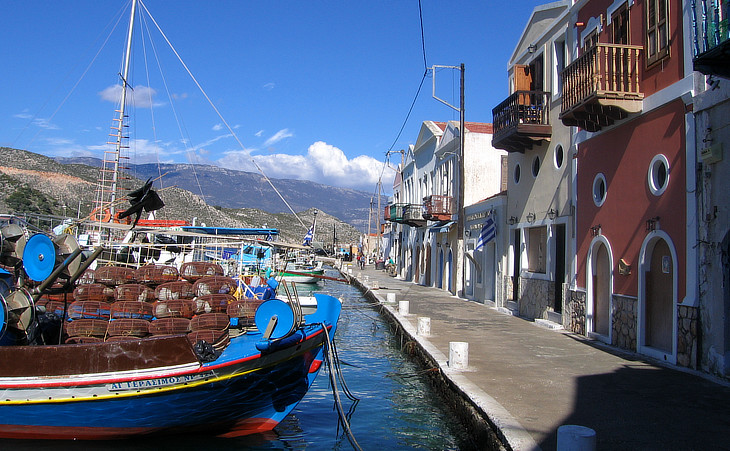
The waterfront where today most of the inhabitants live
The island of Kastelorizo produces absolutely nothing; meat, fruit, command
vegetables, all come from the continent. Beaufort
WWII brought even greater damage than WWI: the bay was used by the Italians for their raids against Alexandria;
in 1941 it was taken by the British forces and retaken by the Italians two days later; in 1943 it was again occupied by the British who declared it a military zone and transferred
the civilians to Cyprus; a fire destroyed most of the town;
then the Germans dislodged the British.
Today the island is a charming place; the photos were taken in the month of February.
Move to:
Introductory page
Rhodes: the Gates
Rhodes: the Fortifications
Rhodes: the Town of the Knights
Rhodes: Byzantine, Ottoman and Jewish memories
Rhodes: modern Italian architecture
Kos: the Fortress
Kos: the Ancient Town
St. Peter's Castle (Bodrum)
Calimno
Lero
Symi
Nissiros
Lindos
Other fortresses

